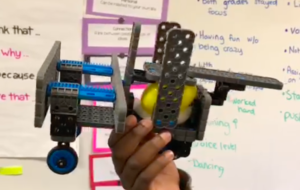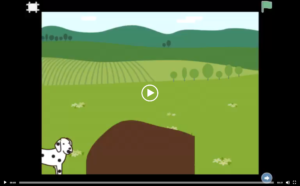As a Project Lead The Way (PLTW) educator, I co-teach with classroom teachers in their classrooms. Students develop 21st-century skills as they work to solve open-ended problems using skills from science, technology, engineering, art, and math (STEAM). Students in my district now enjoy PLTW classes from Young Fives Kindergarten all the way through high school. Students learn the design process beginning in the earliest years by solving open-ended engineering problems. In first grade, they begin learning computer science concepts and skills in a developmentally-appropriate, scaffolded curriculum.
GALLERY OF PLTW/STEAM STUDENT WORK
The student work displayed here represents the teaching of the Project Lead The Way curriculum and other technology lessons. These lessons are based on the following standards:
- Common Core English Language Arts Standards (CCSS.ELA)
- Common Core Math Standards (CCSS.MATH)
- Computer Science Teachers Association K-12 Computer Science Standards (CSTA)
- International Society for Technology in Education Standards for Students (ISTE)
- Next Generation Science Standards (NGSS)
Kindergarten
First Grade
| “Harry the Dirty Dog” Animations Coded Using the App ScratchJr | |
| After learning the basics of block-based coding using the iPad app ScratchJr, we read aloud the classic children’s book “Harry The Dirty Dog.” Students then choose a page (or more) from the book to animate, building computational thinking skills and using their coding skills to convey meaning.
CCSS.ELA-LITERACY.RL.1.2 Retell stories, including key details, and demonstrate understanding of their central message or lesson. CSTA 1A-AP-10: Develop programs with sequences and simple loops, to express ideas or address a problem. |
|
Second Grade
| Butterfly Life Cycle Slideshows Made Using ShadowPuppet Edu | |
| When the schedule allows, classroom teachers and I collaborate on technology integration projects like this one. In a one-day project, students used the app ShadowPuppet Edu to explain the butterfly life cycle. They had spent many days learning about this cycle with their classroom teacher and using technology, were able to explain their understanding in a new way.
CCSS.ELA-LITERACY.W.2.6 With guidance and support from adults, use a variety of digital tools to produce and publish writing, including in collaboration with peers. ISTE Standards For Students 1: Empowered Learner. 1b Students use technology to seek feedback that informs informs and improves their practice and to demonstrate their learning in a variety of ways. |
|
Third Grade
| Repeating Patterns Made Using the Coding App Hopscotch | |
 Click to play video Click to play video |
In third grade, students build on their prior knowledge of coding, adding the knowledge of modules. With this new knowledge, they use the app Hopscotch to create repeating patterns. Students share their work with each other and their families using Seesaw.
CSTA 1B-AP-11: Decompose (break down) problems into smaller, manageable subproblems to facilitate the program development process. NGSS 3-5-ETS1-3 Engineering Design: Plan and carry out fair tests in which variables are controlled and failure points are considered to identify aspects of a model or prototype that can be improved. |
Fourth Grade
| Vehicle Restraints Using VEX IQ | |
 |
Using information they learn about energy and what happens to it in a collision through a series of hands-on activities, students engineer a solution for keeping an egg passenger safe in a crash. This collaborative activity requires students to do research, design and test a prototype, and reflect on their findings.
NGSS 4-PS3-3: Ask questions and predict outcomes about the changes in energy that occur when objects collide. NGSS Science and Engineering Practices: Constructing Explanations and Designing Solutions. Builds on K-2 experiences and progresses to the use of evidence in constructing explanations that specify variables that describe and predict phenomena and in designing multiple solutions to design problems. |
Fifth Grade
| Robotics Challenge to Solve a Real-World Problem Using VEX IQ | |
 |
Students work cooperatively in small groups to build, modify, and program a robot to move autonomously (with minimal human intervention) while also learning to navigate social learning situations and solve a problem that is anchored in the real world. To read more, check out my page: Robotics in Grade 5 – A Formative Assessment.
CCSS.ELA-LITERACY.W.5.9 Draw evidence from literary or informational texts to support analysis, reflection, and research. NGSS ETS1.B Engineering Design: Developing Possible Solutions: Research on a problem should be carried out before beginning to design a solution. At whatever stage, communicating with peers about proposed solutions is an important part of the design process, and shared ideas can lead to improved designs. |
Philosophy and Other Galleries
To learn more about my educational philosophy and class projects, read my Teaching Philosophy or view my gallery of Visual Arts student projects.
IMAGES
All images and videos on this page were created by Sarah Van Loo’s students.


